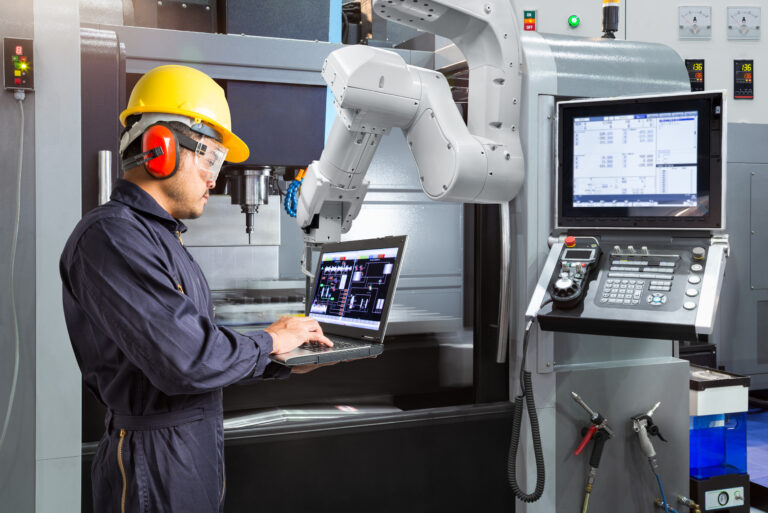Installing new automation equipment is a significant investment in streamlining your operations. However, there are many factors to consider – it’s not possible to simply drop new automation or robotic equipment into your existing workstations or production lines.
Manufacturing and industrial facilities have complex, interconnected systems of both equipment and workers. In most cases a change in one part of the workflow disrupts and alters prior and subsequent steps. This is true whether you’re adding automation or robotics for the first time or upgrading existing equipment.
And that’s why it’s so important to be strategic throughout the project. What makes a turnkey system so effective and fast to get up and running is the time and effort spent on design and prep. In fact, without a comprehensive plan you may encounter more frustration than benefit. In this article we’ll explore some tips for a quick and efficient installation of your automation equipment.
Prepare Your Team
First, let’s start with the number one resource at your business: the people.
Automation and robotics equipment change more than the appearance of your facility. They often change the nature of employees’ everyday job duties and tasks. It’s a big adjustment, even when workers are looking forward to it, and you can help ease the transition by ensuring everyone is prepared. Doing so will help operations continue efficiently with minimal disruptions.
Preparation starts well before any equipment arrives at the facility. Invite and answer questions from your team early in the process. Address their thoughts about the equipment, how it fits within their role, and resolve concerns about working with unfamiliar technology or even of being replaced by a machine. This helps them to feel comfortable with the coming change, lets them know their input is valuable, and encourages buy-in with the whole process.
As a leader or manager, the best way to support your team is to educate and empower them. Make them aware of details including:
- What the new equipment is designed to do
- How it benefits the team in their operations
- What changes to established processes can be expected, including operations up- and downstream from the new equipment
- Who will be responsible for overseeing the machinery
Finally, provide training and resources on how to put the equipment to use, including detailed instructions and diagrams if needed, to help employees stay safe and productive.
Communicate with Your Integrator
Whether you are commissioning a bespoke system or are purchasing a standard, off-the-shelf piece of equipment, communication is paramount. Be as clear and thorough about your facility and operational needs as possible, and ask all of your questions. This gives your integrator the details they need to create a solution that matches your needs.
Information to provide includes (but is not limited to):
- Current and future production goals, including current barriers to these goals
- Available floor space for new machinery
- Quality issues you seek to address with automated or robotic systems
- Details of the existing workflow in your facility, including bottlenecks
Whether or not you have a specific configuration or type of equipment in mind, an experienced integrator, such as Force Design, can identify the best options for your unique situation. In your initial and follow-up meetings you should strive to create a partnership in which you bring expertise and close knowledge of your operations and processes, and your integrator “translates” that information into a well-planned automated system.
Provide Samples for Testing
Throughout the design process your integrator will need samples of the materials, components, and assemblies you manufacture. Providing these allows them to test the equipment to ensure it can replicate or improve upon your existing product quality and manufacturing processes.
Prepare Your Facility
Preparing your facility involves more than just clearing out a large enough space on the floor – though that is certainly an important part of the process.
Your integrator should provide details about the dimensions of your new equipment, the required voltage for its power supply, any other necessary cable connections. Before installation, technicians should make sure there are appropriate connection points and power sources in the correct locations. In addition to electricity, this means checking on Wi-Fi or ethernet connectivity, air or welding gas supply lines, and any other peripheral equipment needed for the area.
Don’t forget to plan how and where you will receive the equipment and move it into place. Have enough space cleared in your loading dock or other entranceway, and ensure halls and walkways are clear. This aids efficient delivery and set up.
Provide Ongoing Training and Support
Once the new equipment has been installed at your facility, provide initial and ongoing training and support to your team. Even the most enthusiastic and tech-oriented of your employees need time to acclimate to the changes in their responsibilities and workflow. Allow plenty of time for questions.
Depending on the application, this should include things such as:
- Basic power and operation instructions
- How to switch out tooling (if applicable)
- Best practices for safe operations, including guards, gates, lockout systems, and other safety equipment
- Tips for troubleshooting and making adjustments
- Working with graphic user interfaces (GUI) on controls
- Monitoring data reports or dashboards included with the equipment
Be sure to inquire about the specific types of technical assistance your integrator provides.
Get Turnkey Automation Equipment for Your Facility Today
At Force Design, we specialize in bespoke automation equipment solutions that are designed for customers’ unique manufacturing needs.
We know that no two manufacturers are the same and neither are their automation applications. That’s why our team of engineers and designers will always take time to learn the details of your operations and your goals. The result is a turnkey installation process so that you can begin boosting your productivity right away.
To learn more, contact us today and speak with someone from our team.



